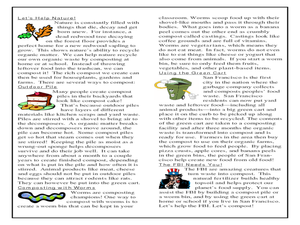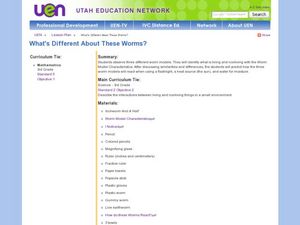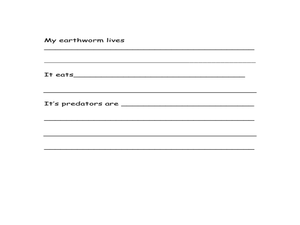Curated OER
Can Worms See?
Second graders discuss the previously created worm compost and the importance of living creatures to the Environment. For this worm lesson, 2nd graders observe worms and record their sensitivity to light. Students design a petri dish...
Curated OER
Worms! Nature's Recyclers
Third graders explore the process of composting. In this composting lesson, 3rd graders read the book Wonderful Worms, and create composters.
Curated OER
Cows, Worms and Compost
Third graders explore agriculture by viewing a PowerPoint presentation in class. In this animal relationship lesson, 3rd graders identify the types of farm animals humans feed on and their dependency on such small insects like worms....
Curated OER
Things We Can Learn From a Cow and a Worm
In this conservation worksheet, students answer 5 questions about how cows and worms recycle and conserve natural resources. Students then fill in a Venn diagram outlining ways they can recycle and conserve.
Curated OER
Willie the Worm
Students explore Earth science by participating in a compost activity in class. In this worm lesson, students discuss the importance of worms in the creation of plants. Students cut out pieces from a print out to assemble a paper worm in...
Curated OER
Life In the Soil: Home Sweet Home: Red Worms
In this soil worksheet, students complete 2 pages about the importance of soil in plant growth. Students read about red worms and answer 2 questions about composting. Students fill out a chart with their observations of plants planted in...
Curated OER
Let's Build a Worm Bin
Students explore the process of decomposition. For this ecology and measurement lesson, students prepare a worm home to be used for vermicomposting. Students weigh a group of worms and the added food, recording this information on a data...
NOAA
Individual Species in the Deep Sea
A tube worm's outer covering is made of chitin, the same material that makes up the shells of lobsters and crabs. Scholars create tube worms and analyze and discuss the longevity of organisms living near cold seeps. They then discuss and...
Curated OER
Three Worm Lesson
Third graders observe properties of three worms. In this living and non-living activity, 3rd graders study characteristics of living and non-living worms. Students experiment to find how light, heat and moisture effects each of the...
Curated OER
What type of soil do worms like?- An Investigation
Students study four types of soil and predict which one worms would use for their habitat. They observe worms in each type of soil and monitor their activity. They create class charts highlighting their discoveries.
NOAA
Animals of the Fire Ice
When the sun's rays can't reach the producers in a food web, where does all the energy come from? Extreme environments call for extreme food sources. Young scientists investigate creatures that appear to get their energy from methane...
Curated OER
Vermicomposting
Second graders create an eco-bin and study the habitat of the worm in soil. In this vermicomposting lesson, 2nd graders observe the effects of water ( too much or too little) and other factors on the eco-bin.
Curated OER
Life Processes
Students identify life processes and create their own creature. In this creative science lesson, students identify an organism's life processes and categorize them into groups. They then create their own creature and write about how it...
Curated OER
Worms in a Bottle
Students gain a better understanding of the worm and its role in the recycling of organic materials into simpler forms by constructing worm bottles and observing for 60 to 90 days.
Curated OER
Vermicomposting
Fifth graders explore agriculture by viewing compost related presentations. In this worm and soil lesson, 5th graders identify the relationship between good soil and the worms who inhabit it by reading assigned text in class. Students...
Curated OER
Specialized Structures and Environments
Fifth graders explore biology by completing an Internet activity in class. In this adaptation lesson, 5th graders identify several organisms and mammals that fight for their existence through slow changes to their anatomy over the course...
Curated OER
Worming Your Way Through the Soil
Students study soil, living and non-living particles in the soil, and learn about composting. In this soil study lesson, students study soil samples and discuss the living and non-living components of the soil. Students classify the...
Curated OER
Characteristics of Living Things
Student use the scientific method to experiment with worms. In this characteristics of living things lesson, students predict and examine the reactions of worms to dry and wet soil. Students share their findings.
Curated OER
Bugs, Worms and Others
Students explore biology by conducting an outdoor research activity. In this insect identification lesson, students collaborate with classmates to examine organisms they find on a class field trip either in their school playground or a...
Curated OER
Animals of the Fire Ice
Students examine ocean life by identifying methane hydrates. In this ocean life instructional activity, students research organisms that live in the coldest, deepest parts of the ocean and live off methane hydrates. Students create a...
Curated OER
Earthworms and Making a Wormery
Learners explore the environment by researching insects. In this earthworm lesson, students utilize soil and plexiglass to build a see through wormery in which learners can observe the worms at work. Students identify the benefits of...
Curated OER
Mini-Ecosystems
Third graders identify the living and non living things in a book read aloud and discuss the interactions represented in the book. Then, they research and include a list of food that each animal needs in an ecosystem. Finally, 3rd...
Curated OER
Sticklers
Students explore biology by participating in a habitat identification activity. In this sticklers lesson, students utilize land markers as part of an organism simulation in which they examine the habitat of a specific species. Students...
Curated OER
Learning About Bugs- What Bugs Do
In this bugs worksheet, 2nd graders examine 7 colorful, clip art bug pictures and read phrases about things bugs do. They match the pictures to their phrases. They see pictures of bugs such as a worm, a caterpillar, a bee, and an ant.
Other popular searches
- Diary of a Worm
- Worm Rhyme
- Meal Worms
- Gummy Worms
- Earth Worms
- Inch Worms
- Worm Composting
- Segmented Worms
- Measurement Grade 3 Worms
- How to Eat Fried Worms
- Wonderful Worms
- Tube Worms

























